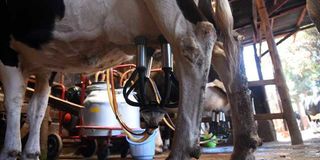The tenacious breeding disease

A cow milking pen. Cattle are naturally infected with brucellosis by ingestion of organisms, which are represent in large numbers in aborted foetuses, foetal membranes and uterine fluids.
I narrated the case of a brucellosis outbreak on a farm in Kiambu weeks ago. The 148 blood samples I took to the laboratory yielded good serum for testing, except one that got spoilt.
The lab complemented my team for the expertise in sample collection, handling and delivery. In many cases, a significant number of samples may get spoilt and fail to yield quality serum.
Samples get spoilt because of poor blood collection techniques that may cause the blood cells to break down in a process called haemolysis. Haemolysed blood samples produce serum with the red colour of blood. Such serum is unfit for brucellosis testing.
Some samples may get spoilt due to poor handling such as shaking and scorching by the sun. Poor labelling can also spoil samples. Illegible labels may cause a sample to be discarded as the source patient cannot be traced.
The sample that got spoilt in my case was due to poor handling that caused the blood to haemolyse.
When collecting samples, labelling and identification of test animals should be done by one person each. This minimises errors.
My article on the brucellosis outbreak elicited interest in farmers, who asked me to describe the disease and tell them if their lands had brucellosis since they had had abortions in their cattle.
None of the farmers appeared to have had brucellosis in their cattle as the abortions had occurred early in the pregnancies.
Abortions
It is, however, difficult to determine the cause of the abortions without visiting farms to examine the animals. I advised the farmers to seek the services of veterinary doctors nearest to them.
I am motivated to write this article to inform farmers and other readers about brucellosis. The disease is tenacious. This means that once it gets into a herd, it is difficult to eradicate.
Records show that brucellosis was first diagnosed in Kenya in 1923. The disease causes abortions mainly around the sixth month of pregnancy. It is caused in cattle by the bacterium Brucella abortus.
Brucella melitensis and Brucellas suis may also infect cattle. The disease is zoonotic, meaning that it can be transmitted from animals to humans.
It is, therefore, an ailment of public health importance.
Further to abortions, brucellosis causes birth of stillborn or weak calves, retained placenta and reduced milk yield.
Infected cattle often abort only once but can still discharge the bacteria in uterine fluids and milk in following calvings. This is important because the organism is highly infectious to humans.
There is no curative treatment available for cattle. Efforts are directed at detection of infected herds and animals and preventing infection from infiltrating uninfected herds and individual animals. Young cattle often abort within a relatively short time frame.
This is called an abortion storm. Attempts to treat the disease cause a carrier status where the animal looks normal but keeps transmitting it to other animals and people.
In this case, the animals started aborting in January 2024 and quickly affected many cows by March the same year.
Cattle are naturally infected with brucellosis by ingestion of organisms, which are present in large numbers in aborted foetuses, foetal membranes, and uterine fluids. Cattle may ingest contaminated feed or water or may lick contaminated genitals of other animals.
Infected bulls or semen may infect cows but this is rare. Brucella organisms may enter the body through mucous membranes, conjunctivae, wounds or intact skin in humans and animals.
Brucellae have been recovered from foetuses and faeces that have remained in a cool environment for more than two months.
Exposure to direct sunlight kills the organisms in hours. This is important because some farmers had asked if it would be necessary to spray disinfectant in the fields brucella-infected cattle have been grazing.
There is no need of spraying because the bacteria would be killed by sunlight. However, it is necessary to rest the fields from grazing for about two months to eradicate the bacteria.
Though the brucella bacteria mainly infect through ingestion, they prefer to settle in the reproductive tissues in cattle and bulls.
In advanced cases, they infect the joints causing arthritis.
Prevention measures
Brucellosis is diagnosed through observation of many abortions in the fourth to seventh months of pregnancy but mainly around the sixth.
There may also be infertility for a while. Confirmation is done in a suitable laboratory.
Since there is no practical treatment available for cattle, control programmes rely on detection of infected herds and preventing infection spreading to “clean” herds.
To eventually eradicate the disease from infected herds, testing and culling of all positive animals is done until no new cases are detected in three consecutive tests.
The greatest danger for the introduction of infection into clean herds is the purchase of new animals and poor disease prevention measures.
Animals joining the herd should be vaccinated calves or non-pregnant heifers. If pregnant or fresh cows are added, they should originate from brucellosis-free areas or herds and be negative.
Cows brought into the herd should be isolated for about 30 days and retested before joining the other animals.
Calves should be vaccinated with B abortus Strain 19 or RB51 to increase their resistance to infection.
However, the resistance may not be total, and some vaccinated calves may still become infected, depending on the severity of an exposure.
Because the disease affects animals and humans, a one approach comprising veterinary, human health and environmental teams should respond to an outbreak with the aim of detecting animal and human cases.
Humans are infected through contact with infective animal materials and consuming infected meat and milk.





